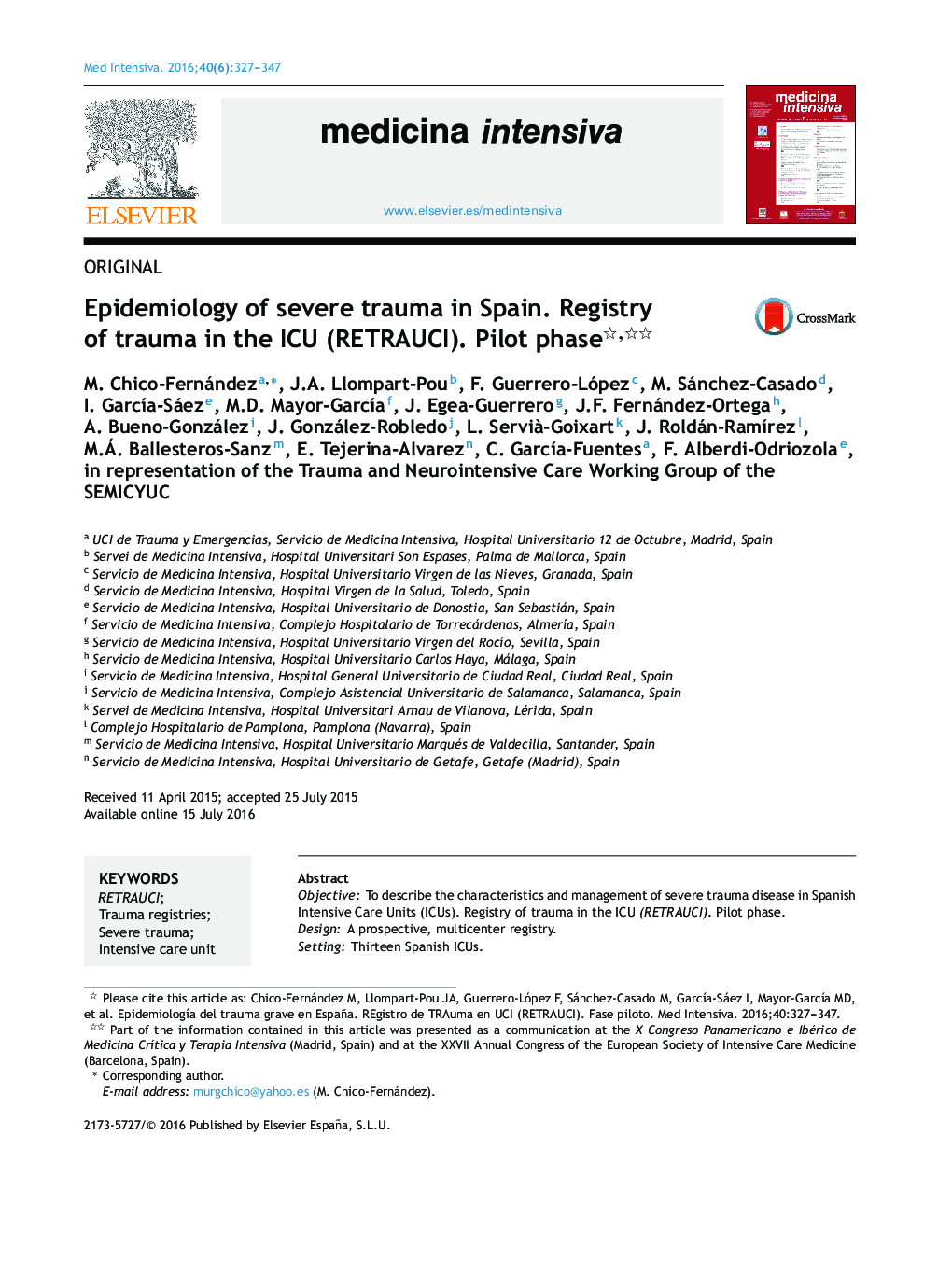| کد مقاله | کد نشریه | سال انتشار | مقاله انگلیسی | نسخه تمام متن |
|---|---|---|---|---|
| 3113950 | 1406717 | 2016 | 21 صفحه PDF | دانلود رایگان |
ObjectiveTo describe the characteristics and management of severe trauma disease in Spanish Intensive Care Units (ICUs). Registry of trauma in the ICU (RETRAUCI). Pilot phase.DesignA prospective, multicenter registry.SettingThirteen Spanish ICUs.PatientsPatients with trauma disease admitted to the ICU.InterventionsNone.Main variables of interestEpidemiology, out-of-hospital attention, registry of injuries, resources utilization, complications and outcome were evaluated.ResultsPatients, n = 2242. Mean age 47.1 ± 19.02 years. Males 79%. Blunt trauma 93.9%. Injury Severity Score 22.2 ± 12.1, Revised Trauma Score 6.7 ± 1.6. Non-intentional in 84.4% of the cases. The most common causes of trauma were traffic accidents followed by pedestrian and high-energy falls. Up to 12.4% were taking antiplatelet medication or anticoagulants. Almost 28% had a suspected or confirmed toxic influence in trauma. Up to 31.5% required an out-of-hospital artificial airway. The time from trauma to ICU admission was 4.7 ± 5.3 h. At ICU admission, 68.5% were hemodynamically stable. Brain and chest injuries predominated. A large number of complications were documented. Mechanical ventilation was used in 69.5% of the patients (mean 8.2 ± 9.9 days), of which 24.9% finally required a tracheostomy. The median duration of stay in the ICU and in hospital was 5 (range 3–13) and 9 (5–19) days, respectively. The ICU mortality rate was 12.3%, while the in-hospital mortality rate was 16.0%.ConclusionsThe pilot phase of the RETRAUCI offers a first impression of the epidemiology and management of trauma disease in Spanish ICUs.
ResumenObjetivoDescribir las características de la enfermedad traumática grave (ETG) y su atención en las unidades de cuidados intensivos (UCI) españolas.DiseñoRegistro multicéntrico y prospectivo.ÁmbitoTrece UCI españolas.PacientesPacientes con ETG ingresados en UCI participantes.IntervencionesNinguna.Variables de interés principalesAspectos epidemiológicos, atención prehospitalaria, registro de lesiones, consumo de recursos, complicaciones y evolución final.ResultadosSe incluyó a 2.242 pacientes con 47,1 ± 19,02 años de edad media, 79% hombres. Fue trauma contuso en 93,9%. El Injury Severity Score fue de 22,2 ± 12,1 y el Revised Trauma Score de 6,7 ± 1,6. Fue no intencionado en el 84,4%. Las causas más frecuentes fueron accidentes de tráfico, caídas y precipitaciones. Un 12,4% tomaban antiagregantes o anticoagulantes y en casi un 28% se implicó el consumo de tóxicos. Un 31,5% precisaron una vía aérea artificial en medio prehospitalario. El tiempo medio hasta el ingreso en UCI fue de 4,7 ± 5,3 h. Al ingreso en UCI un 68,5% se encontraba estable hemodinámicamente. Predominó el traumatismo craneal y torácico. Hubo un importante número de complicaciones y en el 69,5% de los casos necesidad de ventilación mecánica (media 8,2 ± 9,9 días). De ellos, un 24,9% precisaron traqueotomía. Las estancias en UCI y hospitalarias fueron respectivamente de mediana 5 (3–13) días y 9 (5–19) días. La mortalidad en UCI fue del 12,3% y la hospitalaria del 16%.ConclusionesLa fase piloto del RETRAUCI muestra una imagen inicial de la epidemiología y atención del paciente con ETG ingresado en las UCI de nuestro país.
Journal: Medicina Intensiva (English Edition) - Volume 40, Issue 6, August–September 2016, Pages 327–347
